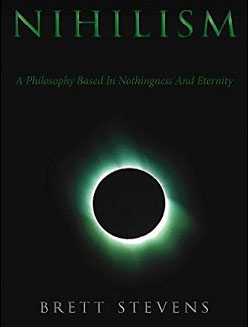Information Cosmos
Great betrayals come from within, and one of the greatest of our time has been science, which like all the really big lies is not so much an outright lie as a partial truth pretending to be the whole of the truth. The eggheads mislead us into thinking they knew more than they did.
As a result, science has hit hard plateaus in a number of fields, churning out answers that appear to be sort of halfway there but also not quite headed in the right direction, which is fine for the careerist eggheads who want to make their names trumpeting minor breakthroughs as new grand unified theories of everything.
Until we can at least make more suppositions about reality, which may be like culture semi-arbitrary but useful for spurring us into thinking forward about our own survival, we will remain in a stagnant repetitive cycle, much like most of Western Civilization has been since WW1.
As our theories of physical sciences fail, we are returning to the idea of idealism in the philosophical sense, meaning that reality has a basis in thoughts or some thought-like substrate:
At its deepest physical foundations, the world appears to be nonlocal: particles separated in space behave not as independent quantum systems, but as parts of a single one.
All particles of the same type — for example, photons or electrons — are entangled with one another, including those on Earth and those in the most distant galaxies. This surprising statement follows from a fundamental postulate of quantum mechanics: particles of the same type are, in their very nature, identical. Does this mean that a universal source of entanglement — underlying the peculiar, nonlocal features of the quantum world — is at our fingertips?
Yet quantum mechanics also points to another, more fundamental mechanism: entanglement — and perhaps nonlocality itself — may arise directly from the identical nature of particles of the same type. From this perspective, nonlocality could even manifest between particles that have never interacted with one another before.
We were looking for an effect-to-cause solution for the order of the universe; that is, we wanted to be able to look at the world as it is, and derive some function of its own that made it occur, instead of looking for an actual cause.
The cause-to-effect view, as Plato noted, involves noting that for every effect — such as existence itself — there is a larger cause which is separate from the effect. Universes do not create themselves; they come about because of a logical need innate to the concept of existence itself.
And so, science rediscovers idealism by noting that perhaps all particles of the same type are entangled with each other, meaning that they all share a logical significance and that this is more important than physical location, sort of like how any realistic ideas throughout history have resonated no matter what year it was.
As a commentator to Plato wrote years ago, the forms are logical, and matter follows those patterns because its need is also regulated by logical rules:
Let us assume the existence of beds and tables. There is one idea of a bed, or of a table, which the maker of each had in his mind when making them; he did not make the ideas of beds and tables, but he made beds and tables according to the ideas.
The idea of a table arises from the need for a table, namely a surface which reacts in certain ways with gravity and inertia, which requires it to have legs that distribute the load in all directions. Do the math on that, and you end up with something like a block or, if weight is an issue, a table.
In this way, the universe produces forms from the first form, which is the consistent of all parts with each other, which produces both relativity and cause-effect logic, necessitating time and space to transact them. The theory of quantum Darwinism holds that principles of logic compete against each other for the most consistency:
Thus, for example, when someone reads this text, their eyes receive photons that interact with their computer or smartphone screen. Another person, from a different viewpoint, will receive different photons, but although the particles in the screen behave in their own strange ways, potentially producing images completely different from each other, interaction with the environment selects for only one kind of behavior and excludes the rest, so that the two readings end up accessing the same text.
Interaction selects for logicality, which means that over time, the universe becomes more logical. As different principles are compared, those that are consistent with the most of what is around them persist. This leads to a situation where intelligence becomes necessary:
Smolin’s CNS seems to err, however, in identifying black holes as the aspect of the universal ‘phenotype’ that is most likely to constitute an adaptation for universe reproduction. The error stems from overlooking what could be considered the ‘first law of Darwinian adaptation’: aspects of a phenotype that exhibit more improbable complexity are more likely to be adaptations. Because intelligent life exhibits higher improbable complexity (and therefore lower entropy) than black holes, it is more likely than black holes to be an adaptation for universe reproduction. From this perspective, biological evolution would represent a developmental subroutine of cosmological evolution, and the ultimate function of intelligent life would be to develop the knowledge and technology that would ultimately enable the universe to reproduce.
From the notion that reality is the effect of an idea-like state which is its cause, we branch outward to the idea of consistency, time, space, gravity, and the existence of logical forms which appear in multiple areas because they address the same need.
As science veers away from a century of increasingly abstruse theories, it rediscovers what the ancients knew all along about our universe.
Tags: cause-effect, forms, german idealism, idealism, metaphysics, platonism, quantum darwinism










